HONDA FIT 2007 1.G Owner's Manual
Manufacturer: HONDA, Model Year: 2007, Model line: FIT, Model: HONDA FIT 2007 1.GPages: 258, PDF Size: 3.52 MB
Page 21 of 258
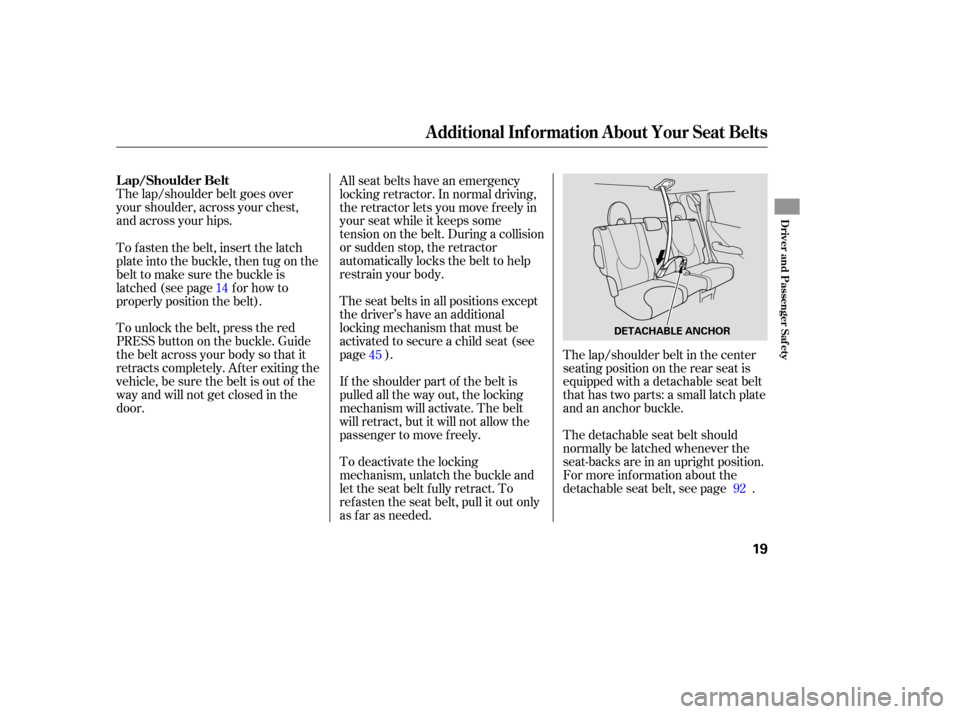
The lap/shoulder belt goes over
your shoulder, across your chest,
and across your hips.
To unlock the belt, press the red
PRESSbuttononthebuckle.Guide
the belt across your body so that it
retracts completely. After exiting the
vehicle, be sure the belt is out of the
way and will not get closed in the
door. All
seat belts have an emerge ncy
locking retractor. In normal driving,
the retractor lets you move freely in
your seat while it keeps some
tension on the belt. During a collision
or sudden stop, the retractor
automati cally locks the belt to help
restrain your body.
The seat belts in all positions except
the driver’s have an additional
locking mechanism that must be
activated to secure a child seat (see
page ).
If the shoulder part of the belt is
pulled all the way out, the locking
mechanism will activate. The belt
will retract, but it will not allow the
passenger to move freely.
To deactivate the locking
mech anism, unlatch the buckle and
let the seat belt fully retract. To
refasten the seat belt, pull it out only
as far as needed.
To
fasten the belt, insert the latch
plate into the buckl e, then tug on the
belt to make sure the buckle is
latched (see page for how to
properly position the belt).
The lap/shoulder belt in the center
seating position on the rear seat is
equipped with a detach able seat belt
that has two parts: a small latch plate
and an anchor buckle.
The detac hable seat belt should
norm ally be latched whenever the
seat-backs are in an upright position.
For more information about the
detachable seat belt, see page .
14
45
92
Additional Inf ormation About Your Seat Belts
L ap/Shoulder Belt
Driver and Passenger Saf ety
19
DETACHABLE ANCHOR
Page 22 of 258
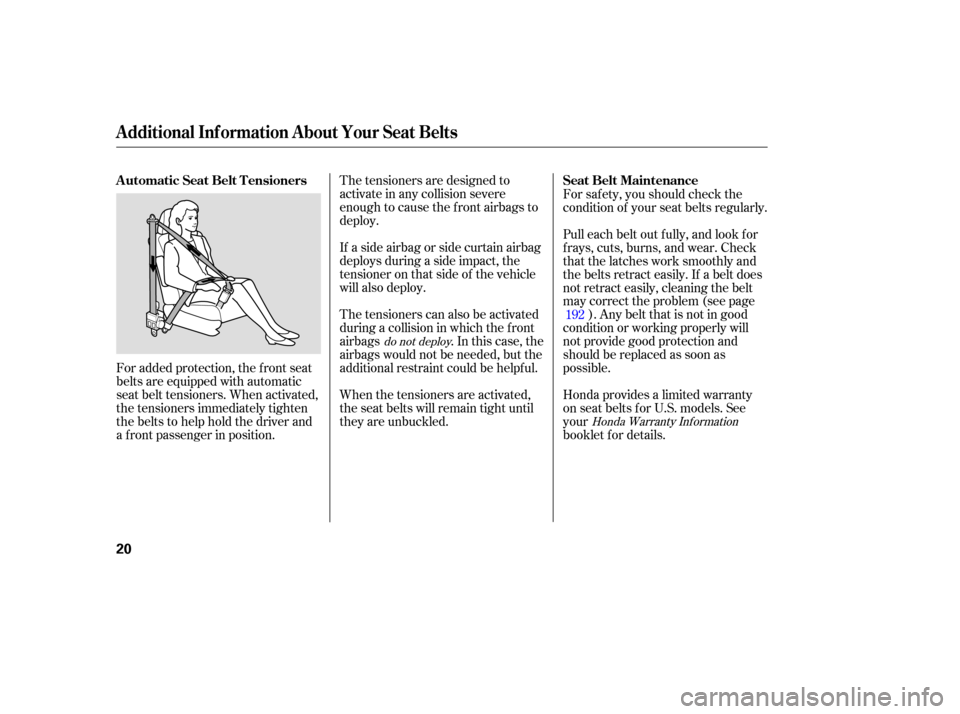
For added protection, the front seat
belts are equipped with automatic
seat belt tensioners. When activated,
the tensioners immediately tighten
the belts to help hold the driver and
a front passenger in position. The
tensioners are designed to
activate in any collision severe
enough to cause the front airbags to
deploy.
If a side airbag or side curtain airbag
deploys during a side impact, the
tensioner on that side of the vehicle
will also deploy.
The tensioners can also be activated
during a collision in which the front
airbags . In this case, the
airbags would not be needed, but the
additional restraint could be helpful.
When the tensioners are activated,
the seat belts will remain tight until
th ey are unbuckl ed. For
safety, you should check the
condition of your seat belts regularly.
Pull each belt out fully, and look for
frays, cuts, burns, and wear. Check
that the latches work smoothly and
the belts retract easily. If a belt does
not retract easily, cleaning the belt
may correct the problem (see page ). Any belt that is not in good
condition or working properly will
not provide good protection and
should be replaced as soon as
possible.
Honda provides a limited warranty
on seat belts f or U.S. models. See
your
booklet f or details. 192
do not deploy
Honda Warranty Inf ormation
A utomatic Seat Belt T ensioners Seat Belt Maintenance
Additional Inf ormation About Your Seat Belts
20
Page 23 of 258

If a seat belt is worn during a crash,
it must be replaced by your dealer. A
belt that has been worn during a
crash may not provide the same level
of protection in a subsequent crash.
The dealer should also inspect the
anchors f or damage and replace
them if needed. If the automatic seat
belt tensioners activate during a
crash, they must be replaced.
Additional Inf ormation About Your Seat Belts
Driver and Passenger Saf ety
21
Not checking or maintaining
seat belts can result in serious
injury or death if the seat belts
do not work properly when
needed.
Check your seat belts regularly,
and have any problem
corrected as soon as possible.
Page 24 of 258
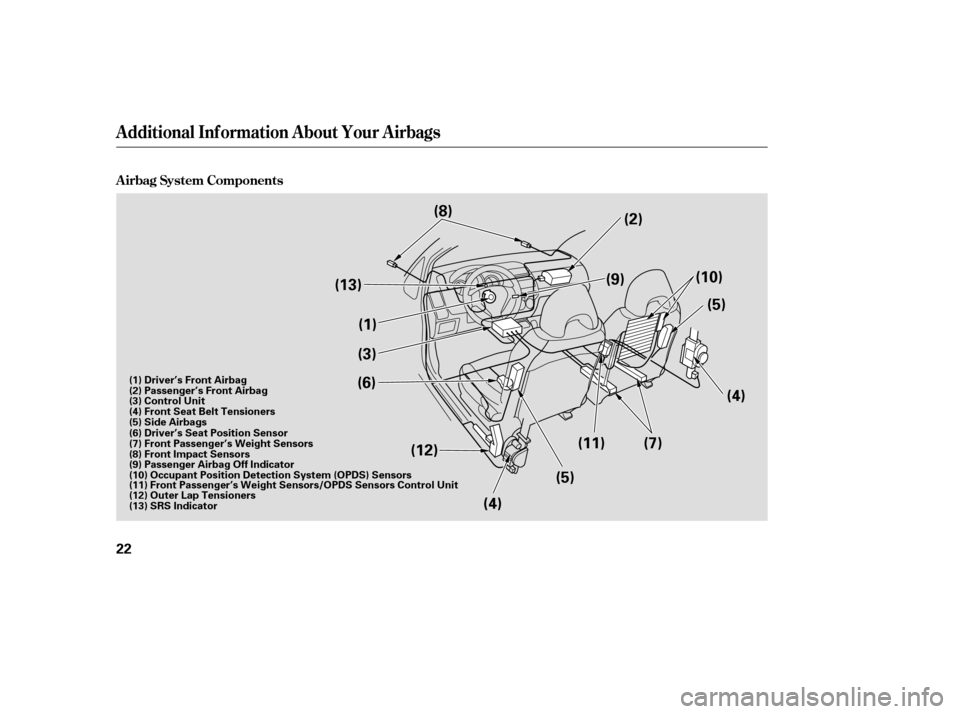
A irbag System Components
Additional Inf ormation About Your Airbags
22
(8)
(1) (2)
(3) (5)
(4)
(13)
(7)(5)
(4)
(6) (10)
(12) (9)
(11)
(6) Driver’s Seat Position Sensor
(7) Front Passenger’s Weight Sensors
(8) Front Impact Sensors
(9) Passenger Airbag Off Indicator
(10) Occupant Position Detection System (OPDS) Sensors
(11) Front Passenger’s Weight Sensors/OPDS Sensors Control Unit
(12) Outer Lap Tensioners
(13) SRS Indicator (1) Driver’s Front Airbag
(2) Passenger’s Front Airbag
(3) Control Unit
(4) Front Seat Belt Tensioners
(5) Side Airbags
Page 25 of 258
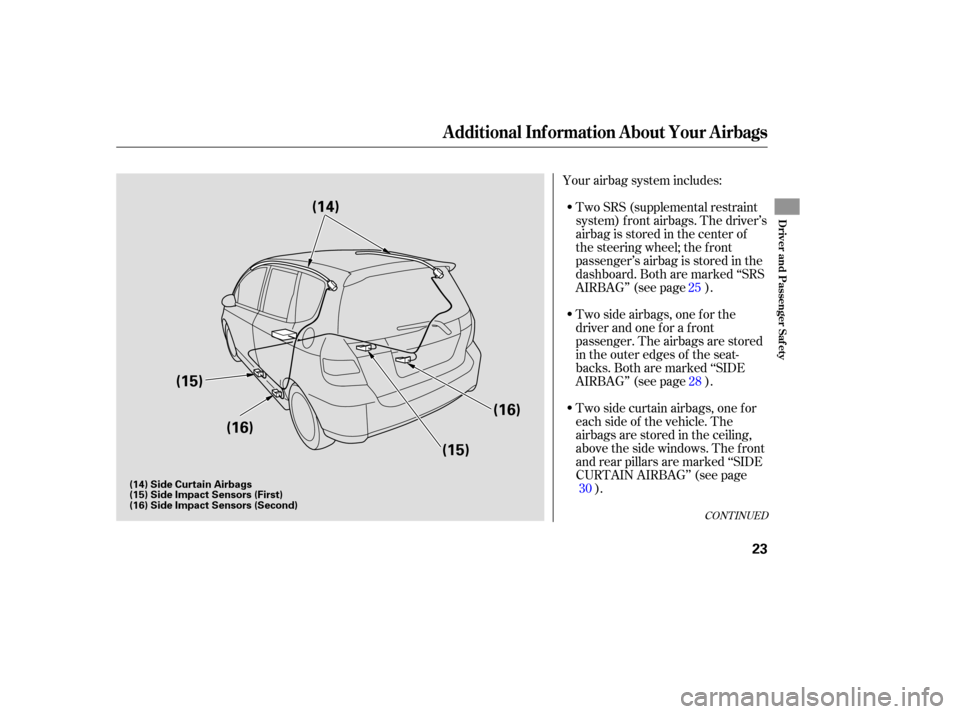
Your airbag system includes:
Two SRS (supplemental restraint
system) front airbags. The driver’s
airbag is stored in the center of
the steering wheel; the front
passenger’sairbagisstoredinthe
dashboard. Both are marked ‘‘SRS
AIRBAG’’ (see page ).
Two side airbags, one for the
driver and one for a front
passenger. The airbags are stored
in the outer edges of the seat-
ba cks. Both are marked ‘‘SIDE
AIRBAG’’ (see page ).
Two side curtain airbags, one for
each side of the vehicle. The
airbags are stor ed in the ceiling,
above the side windows. The front
and rear pillars are marked ‘‘SIDE
CURTAIN AIRBAG’’ (see page ). 25
28
30
CONT INUED
Additional Inf ormation About Your Airbags
Driver and Passenger Saf ety
23
(15)
(15) (14)
(16) (16)
(14) Side Curtain Airbags
(15) Side Impact Sensors (First)
(16) Side Impact Sensors (Second)
Page 26 of 258
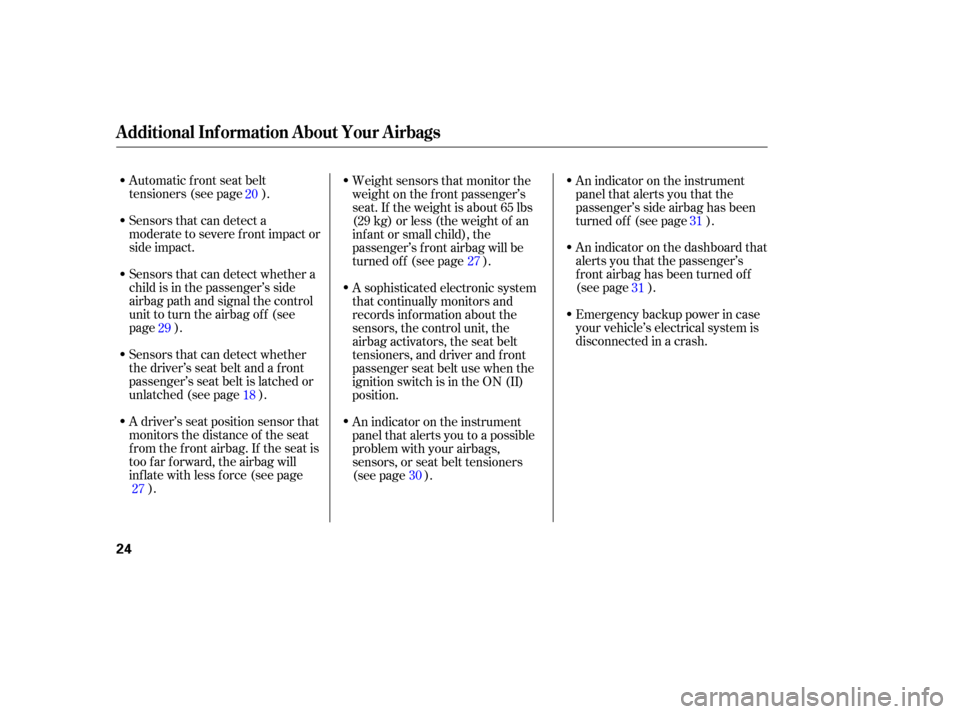
Automatic front seat belt
tensioners (see page ).
Sensors that can detect a
moderate to severe front impact or
side impact.
Sensors that can detect whether a
child is in the passenger’s side
airbag path and signal the control
unit to turn the airb ag off (see
page ). An
indicator on the dashboard that
alerts you that the passenger’s
front airbag has been turned off
(see page ).
Emergency backup power in case
your vehicle’s electrical system is
disconnected in a crash.
An
indicator on the instrument
panel that alerts you that the
passenger’s side airbag has been
turned off (see page ).
Sensors that can detect whether
the driver’s seat belt and a front
passenger’s seat belt is latched or
unlatch ed (see page ).
A driver’s seat position sensor that
monitors the distance of the seat
from the front airbag. If the seat is
too far forward, the airbag will
inflate with less force (see page
). Weight
sensors that monitor the
weight on the front passenger’s
seat. If the weight is about 65 lbs
(29 kg) or less (the weight of an
infant or sm all child), the
passenger’s front airbag will be
turned off (see page ).
A sophisticated electronic system
that continually monitors and
reco rds information about the
sensors, the control unit, the
airbag activators, the seat belt
tensioners, and driver and front
passenger seat belt use when the
ignition switch is in the ON (II)
position.
An indicator on the instrument
panel that alerts you to a possible
problem with your airbags,
sensors, or seat belt tensioners
(see page ). 27
31
31
20
29 18
27 30
Additional Inf ormation About Your Airbags
24
Page 27 of 258
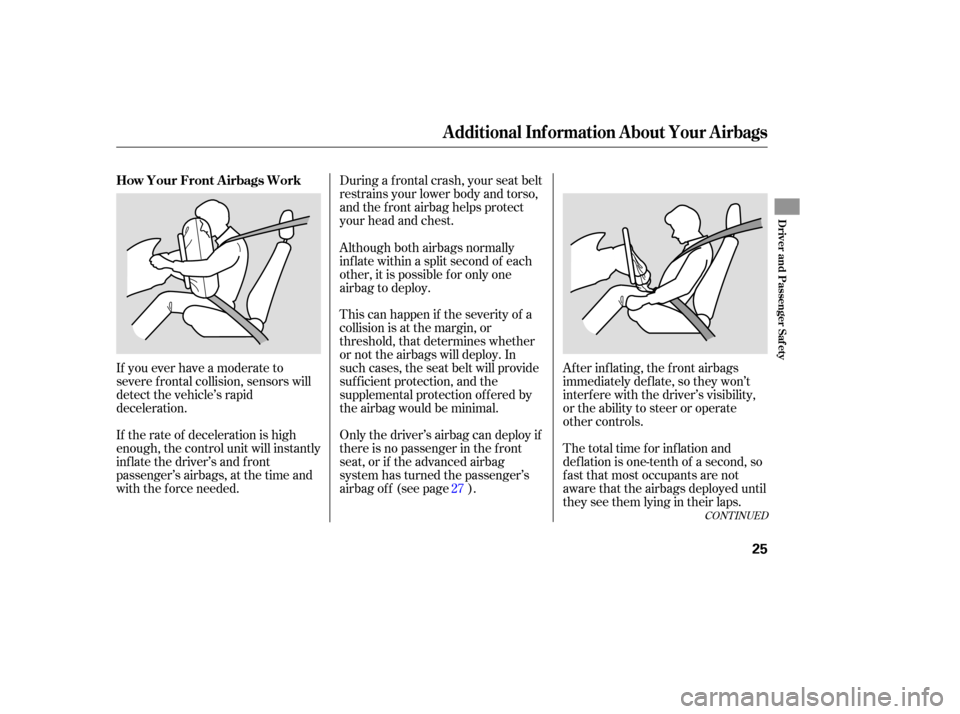
During a frontal crash, your seat belt
restrains your lower body and torso,
and the front airbag helps protect
your head and chest.
This can happen if the severity of a
collision is at the margin, or
threshold, that determines whether
or not the airb ags will deploy. In
such cases, the seat belt will provide
sufficient protection, and the
supplemental protection offered by
the airbag would be minimal.
If
you ever have a moderate to
severe frontal collision, sensors will
detect the vehicle’s rapid
deceleration.
If the rate of deceleration is high
enough, the control unit will instantly
infl ate the driver’s and front
passenger’s airbags, at the time and
with the force needed. Only
the driver’s airbag can deploy if
there is no passenger in the front
seat, or if the advanced airbag
system has turned the passenger’s
airbag off (see page ). The total time for inflation and
def lation is one-tenth of a second, so
f ast that most occupants are not
aware that the airbags deployed until
they see them lying in their laps. Af ter inf lating, the f ront airbags
immediately def late, so they won’t
interf ere with the driver’s visibility,
or the ability to steer or operate
other controls.
Although both airbags normally
inf late within a split second of each
other, it is possible f or only one
airbag to deploy.
27
CONT INUED
Additional Inf ormation About Your Airbags
How Your Front Airbags Work
Driver and Passenger Saf ety
25
Page 28 of 258

Your f ront airbags are also dual-
threshold airbags. Airbags with this
f eature have two deployment
thresholds that depend on whether
sensors detect the occupant is
wearing a seat belt or not.
If the occupant’s belt is ,
the airbag will deploy at a slightly
lower threshold, because the
occupant would need extra
protection.
If the occupant’s belt , the
airbag will inf late at a slightly higher
threshold, when the airbag would be
needed to supplement the protection
provided by the seat belt.
Your f ront airbags are dual-stage
airbags. This means they have two
inf lation stages that can be ignited
sequentially or simultaneously,
depending on crash severity.
In a crash, both stages
will ignite simultaneously to provide
the quickest and greatest protection.
In a crash, one stage will
ignite first, then the second stage
will ignite a split second later. This
provides longer airbag inf lation time
with a little less force.
After a crash, you may see what
looks like smoke. This is actually
powder f rom the airbag’s surf ace.
Although the powder is not harmf ul,
people with respiratory problems
mayexperiencesometemporary
discomf ort. If this occurs, get out of
the vehicle as soon as it is saf e to do
so.
Additional Inf ormation About Your Airbags
Dual-T hreshold A irbags
not lat chedis latched
Dual-Stage A irbags
more severeless severe
26
Page 29 of 258
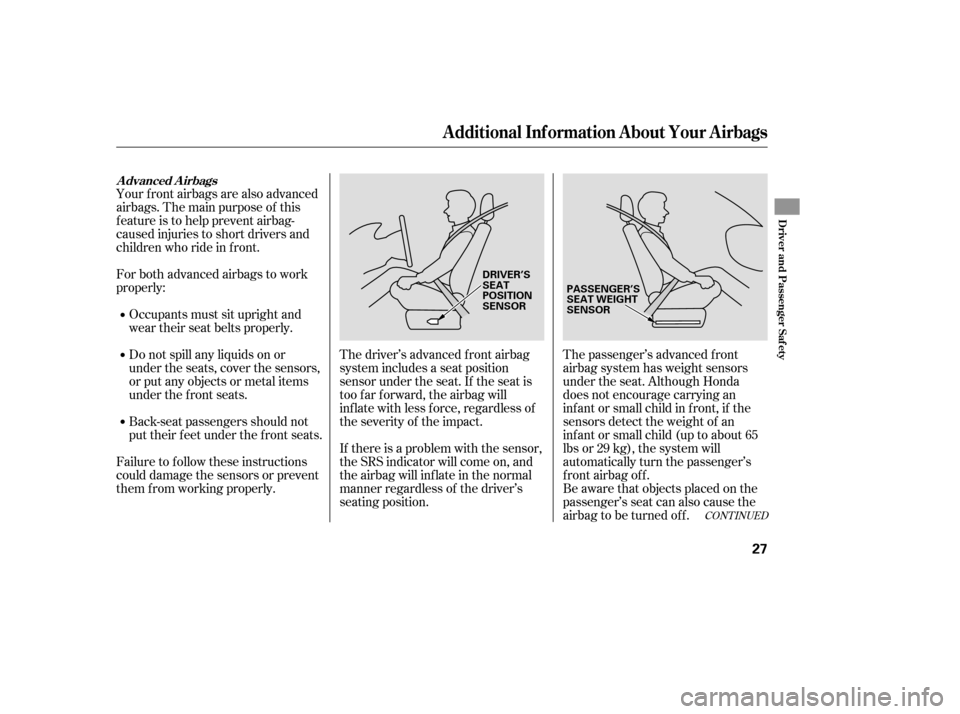
CONT INUED
Your f ront airbags are also advanced
airbags. The main purpose of this
feature is to help prevent airbag-
caused injuries to short drivers and
children who ride in f ront.
For both advanced airbags to work
properly:Occupants must sit upright and
wear their seat belts properly.
Back-seat passengers should not
put their f eet under the f ront seats.
Failure to f ollow these instructions
could damage the sensors or prevent
them f rom working properly. The driver’s advanced front airbag
system includes a seat position
sensor under the seat. If the seat is
too f ar f orward, the airbag will
inf late with less f orce, regardless of
the severity of the impact.
The passenger’s advanced f ront
airbag system has weight sensors
under the seat. Although Honda
does not encourage carrying an
inf ant or small child in f ront, if the
sensors detect the weight of an
inf ant or small child (up to about 65
lbs or 29 kg), the system will
automatically turn the passenger’s
front airbag off.
Do not spill any liquids on or
under the seats, cover the sensors,
or put any objects or metal items
under the f ront seats.
Be aware that objects placed on the
passenger’s seat can also cause the
airbag to be turned off.
If there is a problem with the sensor,
the SRS indicator will come on, and
the airbag will inf late in the normal
manner regardless of the driver’s
seating position.
Additional Inf ormation About Your Airbags
Advanced Airbags
Driver and Passenger Saf ety
27
DRIVER’S
SEAT
POSITION
SENSOR
PASSENGER’S
SEAT WEIGHT
SENSOR
Page 30 of 258
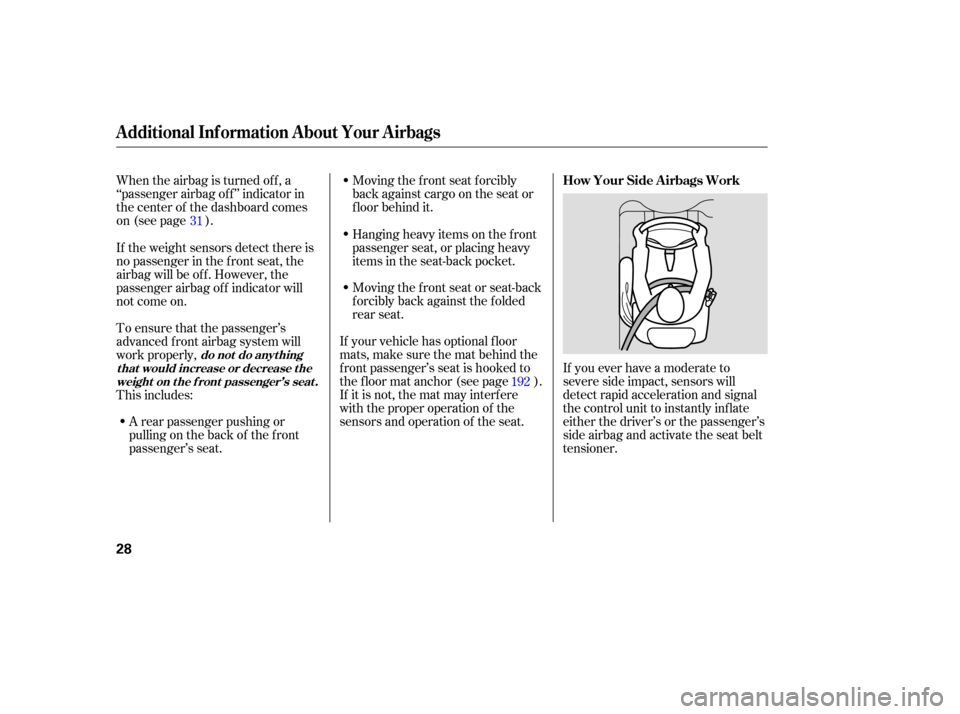
Moving the front seat forcibly
back against cargo on the seat or
floor behind it.
Wh
en the airbag is turned off, a
‘‘passenger airbag off’’ indicator in
the center of the dashboard comes
on (see page ).
If you ever have a moderate to
severe side impact, sensors will
de tect rapid accele ration and signal
the control unit to instantly inflate
either the driver’s or the passenger’s
side airbag and activate the seat belt
tensioner.
Hanging
heavy items on the front
passenger seat, or placing heavy
items in the seat-back pocket.
Moving the front seat or seat-back
fo rcibly back against the folded
rear seat.
If your vehicle has optional floor
mats,makesurethe matbehindthe
f ront passenger’s seat is hooked to
thefloormatanchor(seepage ).
If it is not, the mat may interf ere
with the proper operation of the
sensors and operation of the seat.
If the weight sensors detect there is
no passenger in the f ront seat, the
airbag will be off. However, the
passenger airbag of f indicator will
not come on.
To ensure that the passenger’s
advanced front airbag system will
work properly,
This includes:
A rear passenger pushing or
pulling on the back of the f ront
passenger’s seat. 31
192
Additional Inf ormation About Your Airbags
How Your Side A irbags Work
do not do anyt hing
t hat would increase or decrease t he weight on the f ront passenger’s seat.
28